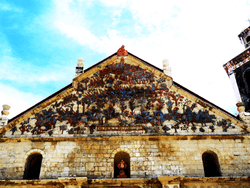San Joaquin Church (Iloilo)
| San Joaquin Church | |
|---|---|
|
San Joaquin Parish Church Iglesia Parroquial de San Joaquin' | |
|
The facade of San Joaquin Church in Iloilo | |
| 10°35′09″N 122°08′27″E / 10.585929°N 122.140910°ECoordinates: 10°35′09″N 122°08′27″E / 10.585929°N 122.140910°E | |
| Country | Philippines |
| Denomination | Roman Catholicism |
| History | |
| Status | Parish church |
| Architecture | |
| Functional status | Active |
| Heritage designation | National Cultural Treasure |
| Designated | 2001 |
| Completed | 1869 |
| Administration | |
| Parish | San Joaquin, Iloilo |
| Archdiocese | Jaro |
The San Joaquin Parish Church (Spanish: Iglesia Parroquial de San Joaquin), commonly known as San Joaquin Church, is a Roman Catholic Church in the municipality of San Joaquin, Iloilo, Philippines within the jurisdiction of the Roman Catholic Archdiocese of Jaro. It is largely known for its pediment featuring a military scene, the Spanish victory over the Moors in the Battle of Tétouan. The church was declared a National Cultural Treasure by the National Museum of the Philippines.
History
The construction of San Joaquin Church was completed in 1869 during the Spanish colonization era[1] by Augustinians.[2] The convent of the San Joaquin Church was left in ruins after the World War II leaving its noted well and kiln which were used for baking.[3]
The then National Historical Institute marked the church as a National Historical Site in 1980 pursuant to Presidential Decree No. 260 of 1973 and Presidential Decree No. 375 of 1974.[3]
In the 1980s the church structure underwent renovations. The side and back walls and the altar area was reinforced by cement by local priest which according to heritage conservationists caused the loss of the structure's integrity and authenticity. The Knight of Columbus constructed an office with cement and heavy trusses on the side of the convent ruins in the 1990s.[3]
The structure was declared a National Cultural Treasure (NCT) by the National Museum of the Philippines (NMP) in 2001.[1] The declaration also covers the convent ruins of the church complex.[3]
In 2015, a restoration was accomplished on the church building under the watch of the National Historical Commission of the Philippines but the lime plaster or palitada used to cover the facade chipped off in less than a year which led to heritage conservationists criticizing the national heritage body.[1]
Following the declaration of the San Joaquin Campo Santo cemetery as a NCT by the NMP, the heritage organization labels the church complex and the cemetery as the "San Joaquin Church Complex and Campo Santo of San Joaquin, Iloilo".[4]
Features

The features of note of the church are its three retablos of carved limestone which were formerly polychromed, the carved pediment which featured the folk portrayal of the Spanish winning over the Moors at the Battle near Tétouan, Morocco as well as its adjacent sprawling ruins where an oven well and kilin for baking can be found. The pediment is described by the National Commission for Culture and the Arts as "second only in magnificence" to that of the Miagao Church.[1][2]
References
- 1 2 3 4 Sembrano, Edgar Allan (14 September 2015). "NHCP slammed for botched restoration of historic San Joaquin Church in Iloilo". Philippine Daily Inquirer. Retrieved 5 March 2017.
- 1 2 "In Focus: The Restoration of 26 Philippine Churches". National Commission for Culture and the Arts. 26 February 2015. Retrieved 5 March 2017.
- 1 2 3 4 Sembrano, Edgar Allan (24 April 2017). "Vendors occupy San Joaquin church convent ruins in Iloilo". Philippine Daily Inquirer. Retrieved 28 September 2017.
- ↑ Sembrano, Edgar Allan (7 November 2016). "National Museum restores desecrated Campo Santo of San Joaquin in Iloilo". Philippine Daily Inquirer. Retrieved 5 March 2017.
External links
![]()